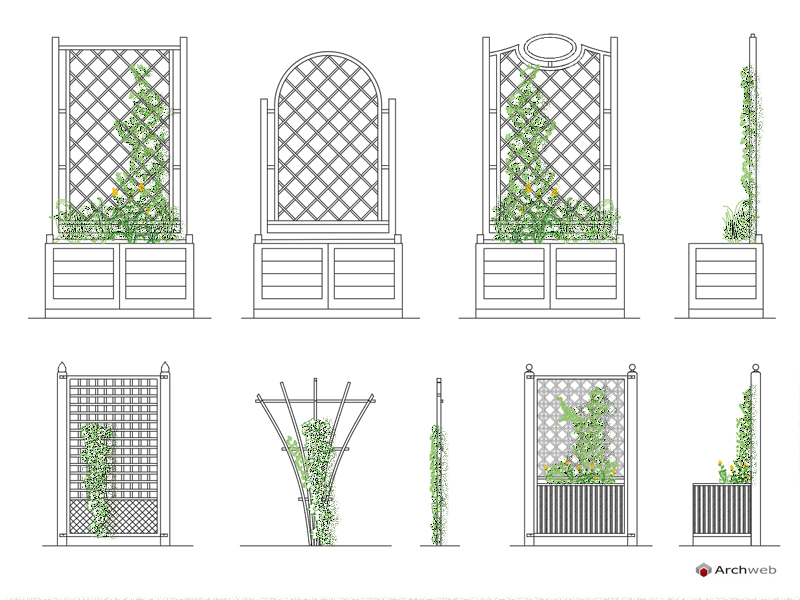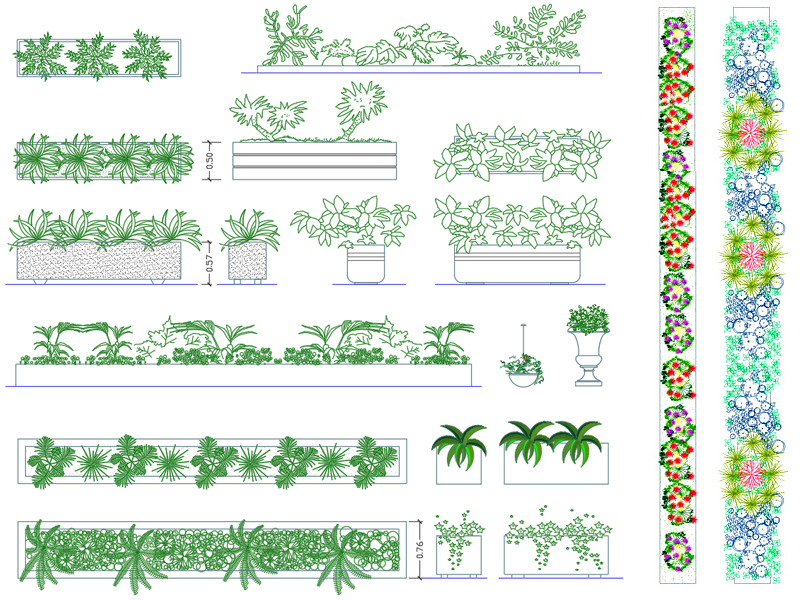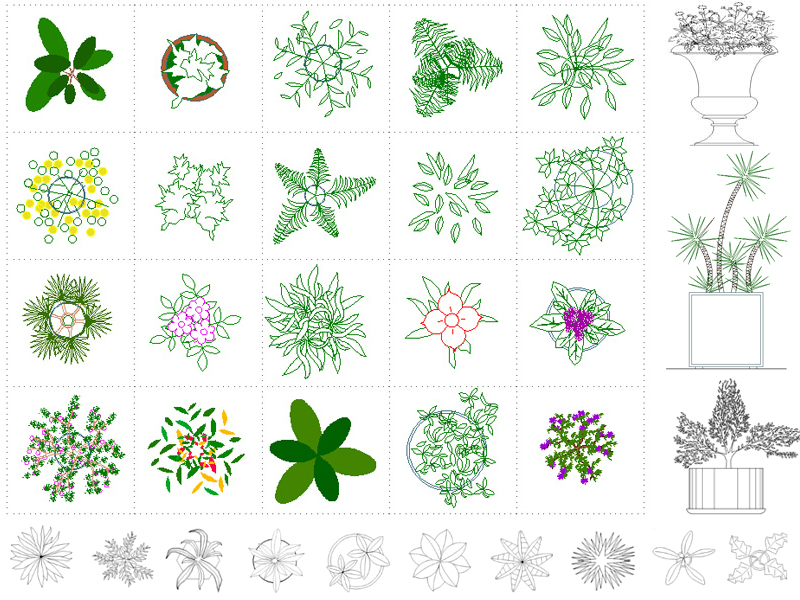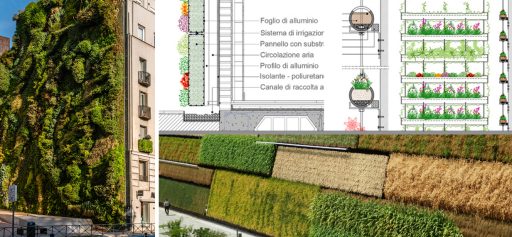The terrace
Precious continuum between inside and outside
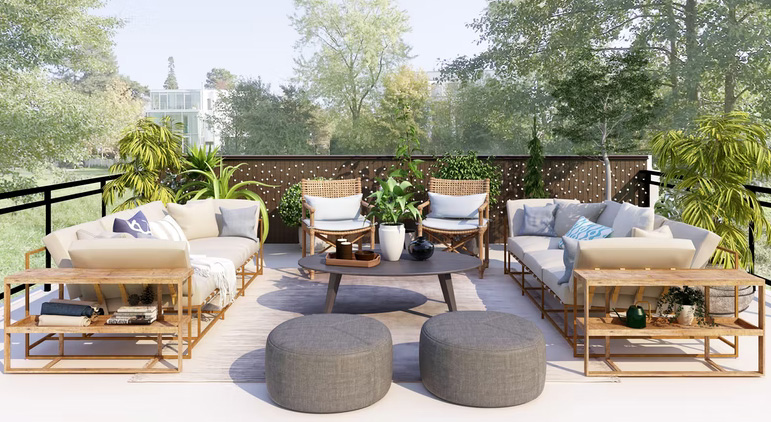
With the arrival of the summer season, everyone dreams of an outdoor corner of their home where they can spend their free time in company or for a little relaxation. This is how balconies, terraces and attics become the real protagonists of the summer, spaces that require adequate care and maintenance.
For this reason, for those who already have a terrace or for those wishing to buy a property that owns it, here are some useful tips to enjoy it to the fullest.
1. Intervention on the outer space: guidelines
Knowing the structure of your terrace is a prerogative for intelligent choices
In the case of new construction but also of renovation or modification on your terrace, it is of fundamental importance to know the structure in order to operate in the best possible way avoiding future mismanagement.
Too often, in fact, the homeowner does not know the design process and the technological choices that have accompanied the actual construction of the spaces he inhabits.
The description of some simple steps will create a greater awareness in users that it will be the same to experience the places of the intervention every day.
Proceeding in stages, as regards the floor of our terrace, it is important as it transmits the load of the weight above it to the supporting structures in elevation.
Everything that we decide to place in the open space in question will have a specific weight and entity and for this we need to be careful and know the structure that will support our environment.
Having said that, the attic of a practicable terrace or balcony is generally made up of the following “layers”:
- roof covering;
- thermal insulation;
- waterproof case;
- mat;
- finishing (flooring).
The application of the insulating layer is aimed at protecting the underlying environments from water infiltrations. To avoid excessive heat exchange between confined spaces, it is necessary to know how to choose the right materials capable of maintaining an “ideal” balance in order to preserve the health of our spaces.
Therefore, the first to be applied are the thermal insulators (which can be synthetic or of vegetable origin) followed by the waterproofing layer (bituminous or liquid sheaths). Subsequently, the screed is inserted which consists of an electro-welded mesh that is drowned in a layer of concrete.
The flooring available in a variety of colors and materials is placed on the screed. Being the most superficial layer, visible, of course it is the one that, in addition to having to be functional and resistant, must satisfy the user’s taste and for this reason it must be chosen with care and awareness. Usually neutral colors are chosen, preferably light to avoid overheating during the day and materials resistant to atmospheric agents. All walkable surfaces must also be non-slip to ensure user safety.
In this regard, safety in open spaces at high altitude is a fundamental prerogative for correct use and the first element to consider is the parapet. This, which can be characterized by a wall or a simple railing, must follow the mandatory provisions set out in Ministerial Decree No. 236 of 14 June 1989. The parapet must have a minimum height of 1 meter and in the case of railings it cannot be crossed by a sphere with a diameter of 10 cm. Furthermore, the terrace space must be such as to guarantee the simple movement of things and people without causing danger and damage.
Another aspect to take into consideration is privacy because, although it can be exciting to live fully the terrace of the house, it is also true that maintaining a good level of confidentiality is everyone’s need. To this end, there are various solutions that can be adopted, from low walls at different heights, to curtains, up to bamboo fences; very pleasing to the eye are the green solutions (bushes, climbing plants) which, in addition to constituting a natural curtain, cool the environment.
If you want to use your outdoor space even in the evening and at night, you need to install light sources for comfortable use. The most used luminaires are wall spotlights, pendant lamps and lanterns and their intensity can be adjusted according to the size of the terrace. However, it is advisable to prefer a diffused and not too aggressive light, remembering that the outdoor space should never be illuminated by day, as it could disturb the eye of those who live there and also that of the neighbors. The ideal is to place the light sources at the top and on the wall, in correspondence with entrances and very used points, where tables, sofas or chairs are placed.
A very suggestive choice is that of floor lighting consisting of spotlights recessed into the floor: it returns a very romantic and relaxing atmosphere but involves the disadvantage of more careful and difficult maintenance. Not to be overlooked is also the economic saving and for this energy saving lamps or solar energy lights are perfect. The latter store solar energy during the day which will be released in the evening when needed. The advantages are the absence of costs in terms of electricity and plant installation, the constant presence of light even in the event of a blackout and respect for the surrounding environment.
How to etricate yourself in the regulatory labyrinth of building permits
If you want to maximize the use of the outdoor space you have available, before deciding how to intervene on your outdoor environment it is important to clarify a rule. In the event that the owner wants to introduce an additional structure on his terrace, for example, depending on the nature of the same, it is necessary to obtain special permits that depend on the specific municipal legislation.
Regarding this, a simple classification can help to proceed according to norms and safety.
– For the structures considered removable and therefore temporary, a permit required by the owner of the space in question from the other condominiums is sufficient.Once the permit is obtained, a simple CIL will follow, or the communication of the start of the works. The interventions in question are part of ordinary maintenance.
– For fixed structures and with a larger footprint, the procedure is slightly more complicated since the PdC, the building permit, and the advice of a qualified technician are required.
As there is still no national legislation regulating this type of intervention, it is necessary to remember to carefully consult the Building Regulations which vary from Municipality to Municipality. To give an example, if you want to install awnings on your terrace, you will need the communication of the start of the work, sometimes preceded by the condominium permit as some housing realities require the choice of certain colors and types of curtains. If the owner intends to introduce a removable structure, since it would cause a change in the volume and morphology of the product, before proceeding he must consult a professional in the sector for the technical-structural verification and for obtaining the necessary documents.
2. Comfort and functionality
At the basis of a good use of the spaces it is important to optimize those that are available, in fact even small outdoor environments are potential easily exploitable lounges. This is possible thanks to the innumerable choices of flexible and space-saving furnishing accessories that have been designed precisely to overcome the problem of the size of the room. On the market there are stackable chairs, expandable tables, multifunctional accessories and folding objects that can be stored in a corner if not used. Aesthetics thus merge with functionality, satisfying taste and at the same time providing solutions for even the most complicated situations.
Second precaution should be dedicated to the choice of furniture and its arrangement in space; it should be remembered that the terrace is seen as a small corner of paradise, a place where you can relax and refresh yourself. For this reason, if space permits, comfortable seats such as armchairs and sofas are preferable, alternatively simple folding chairs made more comfortable with soft cushions.
If you love the most exotic solutions and have the possibility of anchoring the structure to the ceiling or walls, the hammock is the complement that everyone dreams of, it will give you priceless moments of rest.
In the event that the terrace overlooks a pleasant landscape it is good use to make the most of the context, creating a real internal-external continuum on the belvedere. In this case, the choice of a large table and chairs will allow you to have lunch or dinner outside even more pleasantly.
Small spaces – smart solutions
You are not always lucky enough to have large outdoor spaces but it is not for this reason that it is impossible to recreate a small relaxation corner even in balconies and small terraces.
Depending on the shape of our terrace, it is important to study those strategic angles in order to exploit them as tactical areas; if we had a rectangular space, short and narrow, two sofas could be placed on the two smaller sides and a low table in the center, useful as a support for books and drinks. In the case of semi-circular French balconies, the ideal is to retrace the perimeter of the semicircle with cushions and poufs lying on a carpet placed on the ground. In this way you will create a real cozy and original sitting room.
If your balcony instead has a narrow and long shape, the ideal is to create real functional areas distributed in length; create a small dining area thanks to a folding table anchored to the railing, a relaxation area with a sofa overlooking the context and a green space with pots hanging along the balustrade and climbing plants adhering to the wall. The result will be surprising: you will have many spaces to live daily in a few square meters!
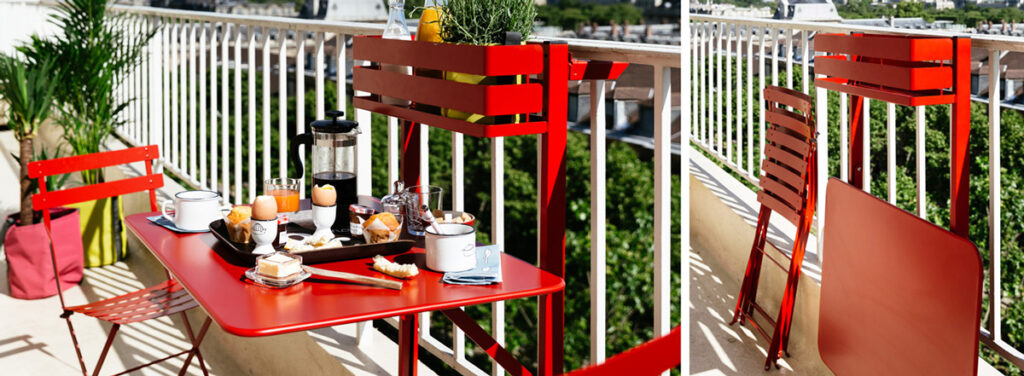
The green element: between ornament and functionality
Many aspire to recreate a small natural space inside their home or on their terraces and it is for this reason that often dealing with the furnishing and setting up of open areas also includes the green aspect. In addition to improving the space and making it more livable, plants have the function of maintaining a constant temperature and shading small portions of space.
There are some precautions that it is important to take into consideration, first of all that of trying to vary with different plant species to ensure that the terrace does not turn into a cultivated greenhouse but maintains a good variety and diversification.
It is also important to choose the types of plants in relation to the exposure of your terrace; if it faces south and therefore are almost always exposed to sunlight, your species will have to endure the heat: geraniums (useful for fighting mosquitoes in summer), lavender and petunia will be perfect.
If space permits, opt for vases and planters, while if the dimensions are small you will find on the market many solutions of limited dimensions that, anchored to the railing, will allow you an excellent saving of walkable space.
Always remember that the absence or scarcity of space does not preclude the organization of your green corner, on the contrary it can be a stimulus to find a creative solution in accordance with personal taste.
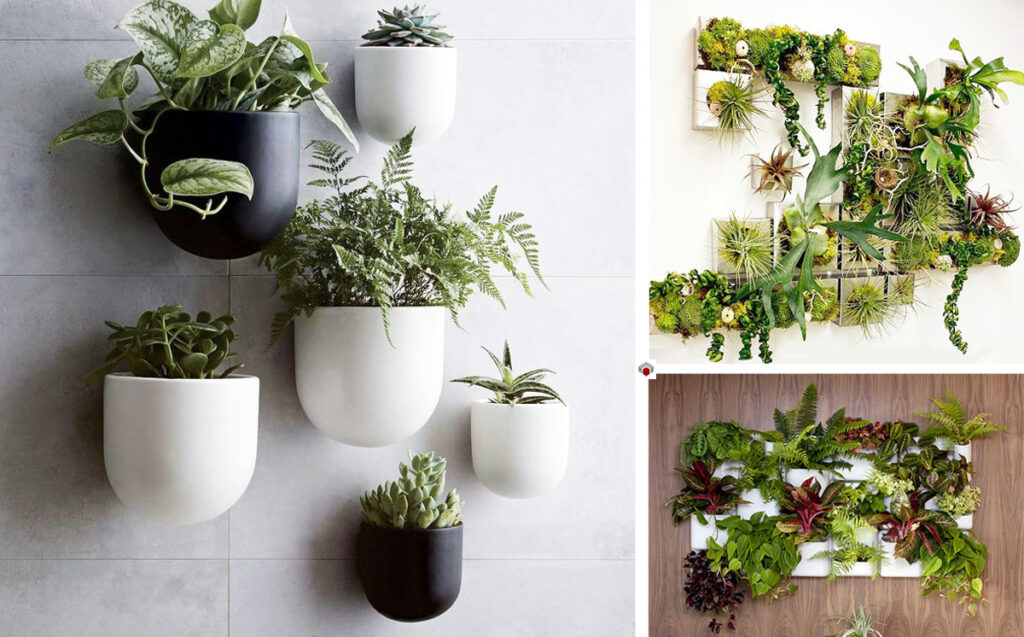
3. Outdoor materials: between physical performance and aesthetics
The design of the outdoor space also includes the choice of materials to be used in the furnishing accessories which, since they are exposed to atmospheric agents, in addition to satisfying the aesthetic taste, must be resistant and long-lasting. Currently there are many solutions on the market that can meet the needs of the most hostile climates and that thanks to their versatility of use can be used for all types of furniture.
Furthermore, the new generation materials guarantee stylistic continuity between the internal and external environments, since they are now applicable to furnishings and accessories designed for both. The prerogative of these materials is certainly that of good resistance, but also that of maintenance that is simple and allows the user a limited commitment of time and energy. It is necessary to choose the materials taking into account some factors such as the space available, the exposure of your terrace, the climatic conditions and the time you have available to manage the environment.
The furniture en plein air
There are several ways to go according to personal taste and needs. There are natural and synthetic materials; both able to guarantee high performance thanks to new technologies, differ in the final effect they will give to your habitat.
• NATURAL FIBERS
WOOD
Always an excellent material used in the construction field, it makes the environment warm and welcoming. ‘humidity. In the past it was used purely in indoor environments but today thanks to the numerous varieties and treatments to which it is subjected, it can also be used in outdoor ones.
Among the most adopted types of wood, teak is certainly the master; of tropical origin, it is famous for its use in the nautical field and its properties include excellent resistance to atmospheric agents. It is particularly appreciated for its warm and elegant appearance that blends with high technical performance and for this reason it is used for outdoor furniture with a strong aesthetic impact. Finally, the different types of treatment and finish allow the same material to take on different aspects, thus making it suitable for completely different contexts.
WICKER
Famous natural fiber obtained from the intertwining of willow branches, it is widely used for exteriors and has the advantage of being light and resistant at the same time. Today available on the market in various colors in addition to neutral, it is a flexible material to use, it can adapt to all environments making them welcoming and giving them a colonial look.
BAMBOO
Obtained from an evergreen plantation, the bamboo stands out for its very rigid and resistant hollow stem. Also used in the East for the construction of stilts and houses, it is found on the market in the form of furnishings and accessories with an exotic appearance. Due to its widespread presence in nature, the cost of this material is relatively low and allows its widespread use.
RATTAN
In the case of rattan, the material is not derived from a single plant but from a large family of plant species from Asia. The processing of the fibers is totally natural: they are cleaned, processed and left to dry in the sun for a long time until they reach the desired appearance. High resistance and high durability are the two strengths of rattan, which, following specific treatments, is used for outdoor furniture.
As for the maintenance of the aforementioned natural materials, it is sufficient to clean them periodically with brushes and cloths soaked in water and neutral soap.In the case of traces of mold, ammonia can be used in a very small quantity because it is important to remember that natural fibers they are as beautiful as they are delicate.
• SYNTHETIC FIBERS
WPC (WOOD PLASTIC COMPOSITE)
If you love the aesthetic aspect of natural wood but do not have the opportunity to dedicate careful maintenance to your furnishings, there is a valid compromise on the market: composite materials. In fact, made from a mix of natural fibers and thermoplastic polymers, they are similar to wood and do not alter over time if exposed to atmospheric agents.
PLASTIC MATERIALS
They are increasingly popular and chosen for their lightness and very low maintenance; the treatments of plastic materials make them resistant to direct light thanks to special pigments that guarantee high durability over time. Washable, light, stackable, plastic is used in the production of modern and easy-to-use furnishings, accessories and lighting equipment.
Today very sophisticated processes are able to give different and original aspects to this material which is transformed and thus takes on the appearance of natural fibers and also of woven and woven fabrics. The impermeability, the low cost, the aesthetic performance and the high technical performance make this material one of the most used.
Some of the most common types are polyethylene, resistant to chemical agents, synthetic resin, very versatile and propylene, resistant and light.
Cleaning of plastic furniture is quick and easy and takes place using water and common detergent.
• METALLIC ALLOYS
ALUMINUM, STEEL, IRON
For those who love modern and minimal style, metals are a great choice. Today, in fact, thanks to the numerous treatments to which they are subjected, they guarantee resistance to bad weather (waterproofing covering, galvanizing, coloring).
Furthermore, maintenance does not require a great deal of effort and cleaning is simple: just treat the surfaces with Marseille soap and dry them with a soft cloth. Instead, all cleaning substances that contain grains are banned.
One of the chosen materials is aluminum, as it is very light, allowing the simple movement of the furniture from one room to another according to the needs of the moment. It has a contemporary appearance, does not tend to corrode and through waxes and oils it offers even higher performance. It is also possible to treat aluminum with powder coatings which further protect it from heat and humidity; however it tends to discolour over time and to remedy this problem it is possible to make it shiny again by simply polishing.
As for steel, it is a stable, durable but heavier material than aluminum. Iron, on the other hand, has the advantage of being robust but the defect of rusting easily; for this reason it is treated with zinc baths that strengthen the surface protecting it from rust.
For those who love classic and traditional environments, wrought iron is recommended, commercially available in a wide range of products.
• OUTDOOR FABRICS
After choosing the furniture, we move on to the accessories, essential to make the environment welcoming and to satisfy personal aesthetic taste. They range from cushions to carpets, from poufs to sheets, all textile elements that, when exposed to the open air and atmospheric agents, must be able to resist and remain unchanged over time.
For this purpose, waterproof materials are perfect, specially designed to cover and enrich outdoor sofas and chairs. The high technical performances are a plus value that make a simple interior fabric usable anywhere; denim, jacquard, cotton, solid colors, patterns and stripes will make the terrace furnishing accessories unique.
4. Style: mirror of one’s personality
Since the terrace is the external continuation of one’s home, it is good practice to furnish it in a manner that conforms to the internal environments. Then, being the corner of paradise a bit for everyone, it will be easy to follow your own taste in the choice of materials, furnishings and decorations in order to arouse sensations of pleasant relaxation.
Arranging the space in coherence with the house and mixing it well with the context can help achieve an excellent result.
Three simple tips, if followed, will simplify the design of your outdoor environment:
- choose furniture and furnishing accessories that are consistent with the style of the interiors;
- ensure the right lighting by choosing light sources suitable for the whole;
- add greenery: plants give life and color to the environment.
Three very different stylistic examples will be illustrated below but easily applicable to individual needs; just be guided by your instinct and your aesthetic taste.
• THE MINIMAL TERRACE
The perfect style for those who love Scandinavian order and rigor is the minimal one.
Introduced in the 1960s as an artistic movement that stood in sharp contrast to previous currents, it quickly gained acclaim all over the world.
One of the most important representatives of the current was Mies Van Der Rohe who with his slogan “Less is more” outlined the cardinal principle: ban on useless decorations in favor of purity of forms. The characteristics of this style are: purity of forms, concreteness, functionality, refined elegance. The reduction to the purest lines and the elimination of the superfluous and the sumptuous are the basis of a philosophy that has made essentiality a real lifestyle.
As for the MATERIALS typical of minimal language, concrete is perhaps the one that most characterizes this style; left exposed it is typical of floors and walls and conveys a sense of solid and austere concreteness. Furthermore, it is a resistant and long-lasting material that is nowadays also highly appreciated from an aesthetic point of view. For the furnishings, on the other hand, innovative materials are used such as metals and lacquers for structures and profiles, crystals and glass for the tops and plastic and leather for the seats. This type of choice blends traditional elements with modern solutions with a hi-tech flavor.
The COLORS palette includes neutral shades that include white, shades of gray, black and sometimes shades of brown. If you want to surprise, an element of intense color such as red or yellow is allowed in order to create an unexpectedly appreciated contrast. Other colors that can be found in a minimal environment are the pastel ones of sage green and yellow, but these are particular cases in which the taste of the user meets that of the typical colors of the 60s.
The spatial arrangement of the FURNITURE is of fundamental importance, each piece must be placed in an orderly manner without being too bulky. Functionality is the basis and everything must be within reach; often the seats follow the perimeter of the terrace, while the table acts as the only central fulcrum.
The favorite shapes for all the furnishings are geometric, pure and with a clean and square cut, according to the rigor and minimal elegance. Remembering to eliminate all that is superfluous and unnecessary, cushions, rugs and vases with solid colors and bright tones in contrast with the neutral whole will be welcome.
Attention to detail and attention to detail will make your environment unique: focus on ornamental plants and light points to be able to use your terrace even in the evening. Few lamps, with simple, geometric shapes and white light, preferably in metal so that they give a modern and sterile touch.
Below is an example of a minimal style terrace where neutral colors and contemporary furnishings predominate.
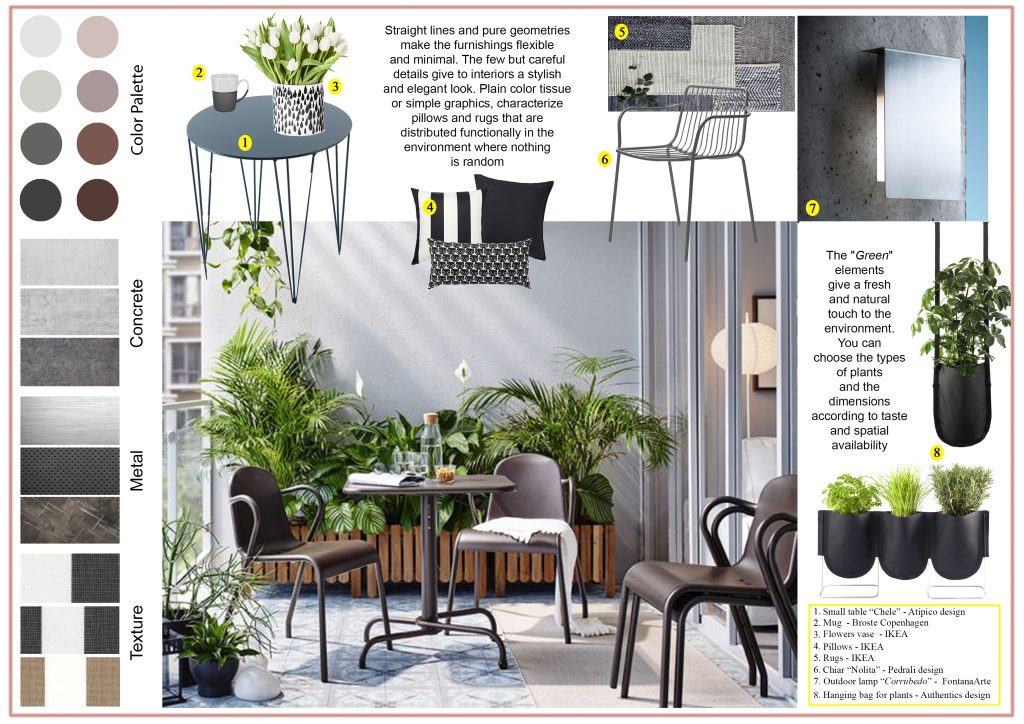
• THE MEDITERRANEAN TERRACE
Influenced by the southern European and African cultures bordering the Mediterranean Sea, this style is contracted to be refined and elegant. Italy, Greece and Morocco are considered the precursors of a culture that embraces the colors of the earth and the traditions of ancient peoples.
The underlying principles are the emulation of natural elements such as the earth and the sea in shapes and colors. The ultimate goal is to make the open-air environment welcoming and familiar by proposing chromatic and formal choices that recall nature and the sea and convey feelings of peace and relaxation.
The chosen MATERIALS for lovers of the Mediterranean style are natural ones: white lime, stone, terracotta, stoneware, wood. The walls of the terrace are strictly white, with exposed plaster or enriched with majolica characteristics, small tiles that show sinuous designs and motifs. In fact, ceramics are a real leitmotiv, usable on floors and walls, they cannot be missing.
The flooring of the Mediterranean terrace as well as featuring mosaic-effect ceramic tiles can be made of terracotta or porcelain stoneware, a versatile and resistant material. As for the choice of COLORS it will be very simple! Just be inspired by the colors of nature and the seascape. The earthy shades of the red and yellow sands blend with the bright colors of blue and turquoise typical of the sea. Do not miss the white of the sea foam, the aqua green and the ocher yellow, symbol of a luxuriant nature.
From the standpoint of the setting, the terrace will become a warm and welcoming environment where the FURNITURE will be enriched with accessories and decorations entirely inspired by nature. The tables and seats can be in colored iron with sinuous shapes and inlays but rattan furnishings with wrought iron profiles and inserts in rich fabric also adapt well to the environment. Depending on your tastes, you can choose lighter and more modern or elaborate and powerful furniture, the former will give a fresh touch, the latter will give an older look.
To enrich the furnished space, lanterns, candles, rope ornaments and shells are just some of the evocative elements of the maritime landscape. However, this type of terrace is not linked to its location, so suitable for summer residences by the sea, it can be an excellent corner of paradise in the townhouse. The most chosen decorations are the handcrafted ones: amphorae, ceramic vases, poufs and cushions with rich textures and deep blue colors.
The fabrics that are placed on seats and sofas are natural and light: linen, organic cotton and raffia. To complete the project of the open space, an element that enriches and refreshes is the green; the most suitable for this environment are the plants of the Mediterranean scrub and citrus fruits, some species of which can be planted in pots.
Below is an example of a Mediterranean-style terrace where intense and bright colors and elements inspired by the seascape predominate.
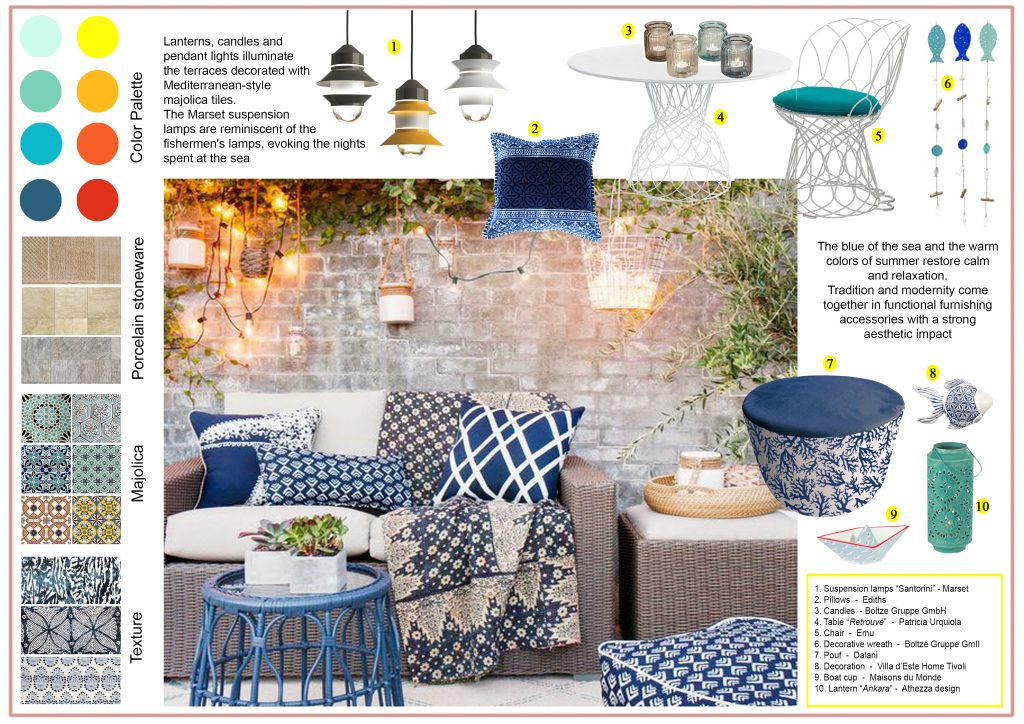
• THE ETHNIC TERRACE
Unlike the other two styles, for the ethnic one there are no specific rules to follow, it is a real mix of different cultures and elements and the greatest difficulty lies in obtaining a harmonious and not too redundant result. The solution to the problem lies in finding a common thread, an element that unites all the furnishings and accessories even if they belong to different styles. The color, a material, a shape, will be enough to create a harmonious and pleasant to the eye.
The origin of this colorful style is distant and can be found in different cultures: Morocco, India, Africa, the Far East. It is essential to observe the differences that distinguish each territory and to understand which cultures to refer to specifically.
At the base is creativity and personal taste thanks to which you can recreate a balanced environment without referring to rigid dictates. COLORS are of fundamental importance for the ethnic style, bright and lively must be used sparingly to avoid heavy and too much effects. chaotic. The warm and lively colors of yellow, orange, red and purple prevail, mixing with sand colors, giving the environment a lively and welcoming touch.
On the choice of MATERIALS it is better to prefer natural ones, wood for the floors, teak, bamboo and rattan for the furnishings. The wood is available in various formats and qualities: planks, polished pallets, in dark and light shades, with a more raw but also more refined effect. A more sophisticated solution is that which involves the insertion of cement tiles with colorful shapes and colors on the floor, an excellent choice to enhance the environment and give it a retro flavor.
As for the FURNITURE there are no real distribution schemes but the choice of the type of furniture is really important. In fact, if you want to recreate the typical atmosphere of “a tea in the desert” the first rule is the low table, accompanied by cushions and poufs used as seats, it will be perfect for a break in the open air. On the ethnic terrace, furnishing accessories and fabrics will not be missing that will enrich the environment: perforated lanterns, candles with spicy scents, hookahs, incense, fabrics and silks with strong tones and embroidered textures.
The final touch to make the terrace more vital and ensure a greater degree of well-being, consists in inserting some species of plants and in the specific case of the ethnic style the most suitable are succulents, with an undemanding maintenance, giving color and originality. to the environment.
Below is an example of an ethnic-style terrace where the mixture of elements and color gives originality and evokes images of distant destinations.
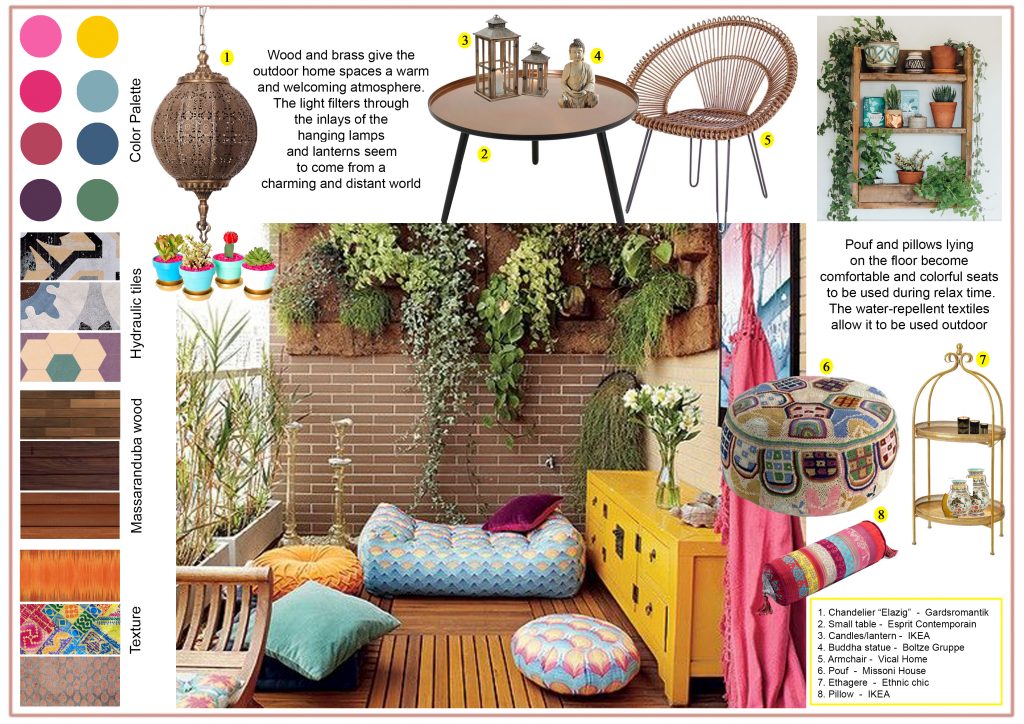
Photo cover: “Collov Home Design” on unsplash
Moodboard by Chiara Del Core



























































